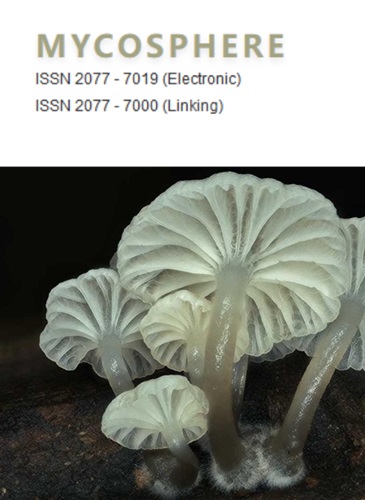Three new species of Hypoxylon and new records of Xylariales from Panama
IF 15.1
1区 生物学
Q1 MYCOLOGY
引用次数: 8
Abstract
Three new species of Hypoxylon (Hypoxylaceae, Xylariales) are described based on a polyphasic approach that included morphological examination, molecular phylogeny and chemotaxonomic studies of specimens collected in Panama. Specifically, we compared the sexual morph (stromata, asci, and ascospores) of the specimens collected with known species of Hypoxylon and inferred a phylogeny of this genus based on a Randomized Axelerated Maximum Likelihood (RAxML) analysis of partial β –tubulin (TUB2) DNA sequences and the internal transcribed spacer regions (ITS). Hypoxylon baruense sp. nov. is phylogenetically related to H. subgilvum but differs in the shape of stromata, and by having larger ascospores and a smooth perispore. Hypoxylon bellicolor sp. nov. is phylogenetically well differentiated, featuring effused– pulvinate stromata with orange granules and ostioles lower than the stromatal surface. Hypoxylon sporistriatatunicum sp. nov. , is phylogenetically related to H. shearii var. minor but differs in the shape of the stromata, in having ostioles higher than the stromatal surface, and in having larger ascospores. The secondary metabolite profiles of these species were studied by HPLC–DAD–MS and these correspond to the results of the morphological and phylogenetic studies. Additionally, we also report Amphirosellinia evansii, H. howeanum, H. cinnabarinum and Stilbohypoxylon quisquiliarum from Panama for the first time and Citrus sinensis as a new host of H. cinnabarinum . With this work, the number of species of Xylariales and Hypoxylon reported from Panama have increased to 103 and 18, respectively. – 7 μm (n=6), with apical apparatus bluing in Melzer’s reagent, 2 – 3.6 μm long x 1 – 1.4 μm broad (n=5). Ascospores: dark brown, unicellular, ellipsoid–inequilateral, 10–15 x 5– 7.6 μm (n=50), with straight conspicuous germ slit less than spore–length; perispore indehiscent in 10% KOH, smooth. Culture characteristics – Colonies on PDA covering a 60 mm Petri dish in 3 weeks, mycelium white above, reverse dark green, with concentric zones. No asexual morph observed in the culture media used i.e. PDA, 2% MEA, V8 agar, oatmeal agar and potato carrot agar. (n=11). Ostioles: than the stromatal标题巴拿马木属三新种及木属新记录
摘要采用多相分析方法,对巴拿马地区的木氧树(Hypoxylon, Xylariales)进行了形态学、分子系统发育和化学分类研究。具体来说,我们将收集到的标本的性形态(间质、子囊和子囊孢子)与已知的Hypoxylon物种进行了比较,并基于部分β -微管蛋白(TUB2) DNA序列和内部转录间隔区(ITS)的随机轴加速最大似然(RAxML)分析推断出该属的系统发育。baruense sp. 11 .在系统发育上与H. subgilvum有关,但在基质的形状上不同,并且具有较大的子囊孢子和光滑的外孢子。belicolor sp. 11 .在系统发育上分化良好,具有渗出的绒毛状基质和橙色颗粒,气孔低于基质表面。在系统发育上与H. shearii var. minor有亲缘关系,但在基质形状、气孔高于基质表面、子囊孢子较大等方面有所不同。HPLC-DAD-MS分析了这些物种的次生代谢物谱,这些谱与形态学和系统发育研究结果相一致。此外,我们还首次报道了来自巴拿马的埃文氏Amphirosellinia evansii、H. hoanum、H. cinnabarinum和Stilbohypoxylon quisquiliarum,以及柑橘属sinensis作为H. cinnabarinum的新寄主。通过这项工作,在巴拿马报告的Xylariales和Hypoxylon的种类分别增加到103种和18种。- 7 μm (n=6),顶端装置在Melzer试剂中发蓝,2 - 3.6 μm长,1 - 1.4 μm宽(n=5)。子囊孢子:深棕色,单细胞,椭球体不等边,10-15 x 5 - 7.6 μm (n=50),具有明显的直芽缝,小于孢子长度;在10% KOH时,孢子囊不裂,光滑。培养特点-菌落在PDA上覆盖60毫米培养皿3周,菌丝上方为白色,背面为暗绿色,有同心区。在PDA、2% MEA、V8琼脂、燕麦琼脂和马铃薯胡萝卜琼脂培养基中未观察到无性形态。(n = 11)。气孔:比基质
本文章由计算机程序翻译,如有差异,请以英文原文为准。
求助全文
约1分钟内获得全文
求助全文
来源期刊

Mycosphere
MYCOLOGY-
CiteScore
30.00
自引率
8.20%
发文量
9
审稿时长
4 weeks
期刊介绍:
Mycosphere stands as an international, peer-reviewed journal committed to the rapid dissemination of high-quality papers on fungal biology. Embracing an open-access approach, Mycosphere serves as a dedicated platform for the mycology community, ensuring swift publication of their valuable contributions. All submitted manuscripts undergo a thorough peer-review process before acceptance, with authors retaining copyright.
Key highlights of Mycosphere's publication include:
- Peer-reviewed manuscripts and monographs
- Open access, fostering accessibility and dissemination of knowledge
- Swift turnaround, facilitating timely sharing of research findings
- For information regarding open access charges, refer to the instructions for authors
- Special volumes, offering a platform for thematic collections and focused contributions.
Mycosphere is dedicated to promoting the accessibility and advancement of fungal biology through its inclusive and efficient publishing process.
 求助内容:
求助内容: 应助结果提醒方式:
应助结果提醒方式:


